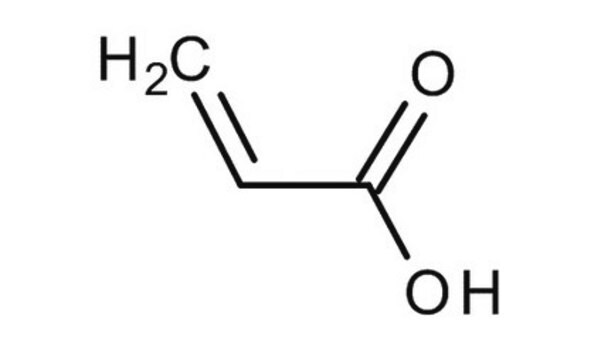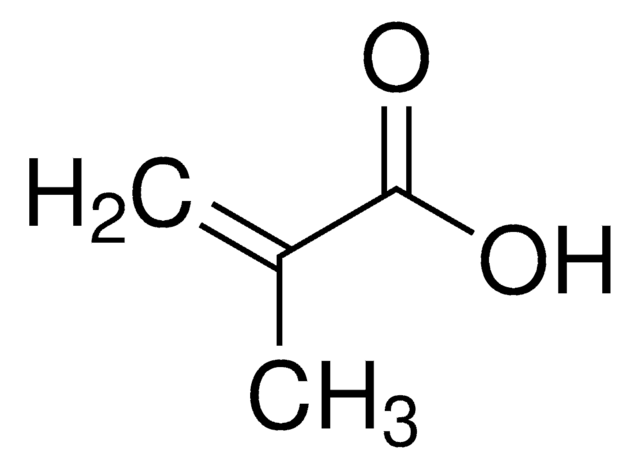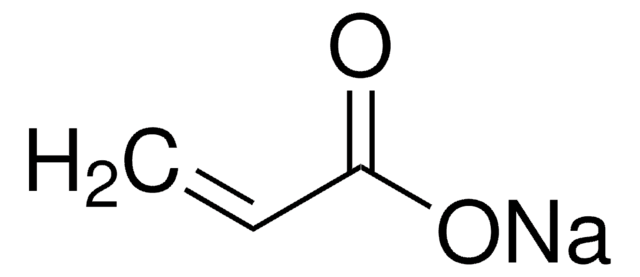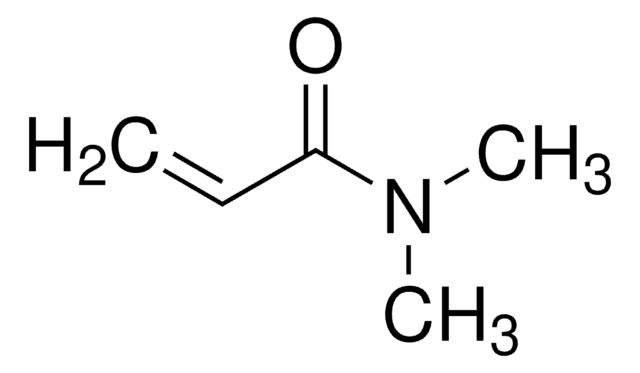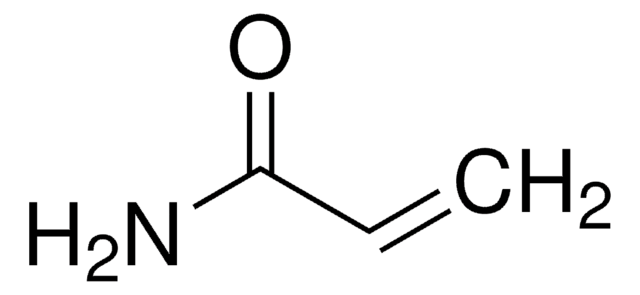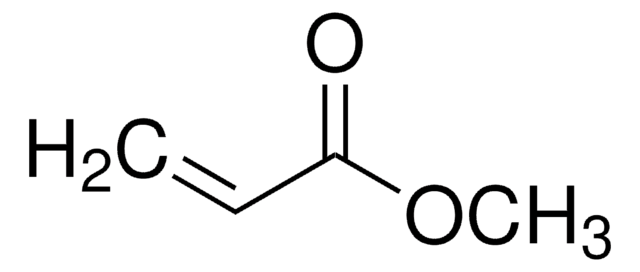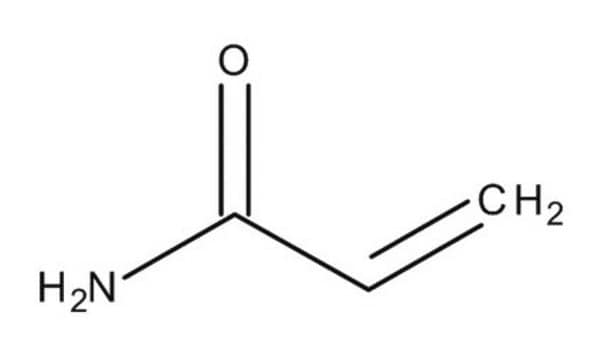推荐产品
等级
anhydrous
质量水平
蒸汽密度
2.5 (vs air)
蒸汽压
4 mmHg ( 20 °C)
检测方案
99%
形式
liquid
自燃温度
744 °F
包含
200 ppm MEHQ as inhibitor
expl. lim.
13.7 %
bp
139 °C (lit.)
mp
13 °C (lit.)
密度
1.051 g/mL at 25 °C (lit.)
SMILES字符串
OC(=O)C=C
InChI
1S/C3H4O2/c1-2-3(4)5/h2H,1H2,(H,4,5)
InChI key
NIXOWILDQLNWCW-UHFFFAOYSA-N
正在寻找类似产品? Visit 产品对比指南
一般描述
应用
警示用语:
Danger
危险分类
Acute Tox. 3 Dermal - Acute Tox. 4 Inhalation - Acute Tox. 4 Oral - Aquatic Acute 1 - Aquatic Chronic 2 - Eye Dam. 1 - Flam. Liq. 3 - Skin Corr. 1A - STOT SE 3
靶器官
Respiratory system
储存分类代码
3 - Flammable liquids
WGK
WGK 2
闪点(°F)
119.3 °F - closed cup
闪点(°C)
48.5 °C - closed cup
个人防护装备
Faceshields, Gloves, Goggles, type ABEK (EN14387) respirator filter
法规信息
分析证书(COA)
输入产品批号来搜索 分析证书(COA) 。批号可以在产品标签上"批“ (Lot或Batch)字后找到。
已有该产品?
为方便起见,与您过往购买产品相关的文件已保存在文档库中。
难以找到您所需的产品或批次号码?
如何查找产品货号
在网站页面上,产品编号会附带包装尺寸/数量一起显示(例如:T1503-25G)。请确保 在“产品编号”字段中仅输入产品编号 (示例: T1503).
示例
其它示例:
705578-5MG-PW
PL860-CGA/SHF-1EA
MMYOMAG-74K-13
1000309185
输入内容 1.000309185)
遇到问题?欢迎随时联系我们技术服务 寻求帮助
如何查找COA批号
批号可以在产品标签上"批“ (Lot或Batch)字后面找到。
Aldrich 产品
如果您查询到的批号为 TO09019TO 等,请输入去除前两位字母的批号:09019TO。
如果您查询到的批号含有填充代码(例如05427ES-021),请输入去除填充代码-021的批号:05427ES。
如果您查询到的批号含有填充代码(例如 STBB0728K9),请输入去除填充代码K9的批号:STBB0728。
未找到您寻找的产品?
部分情况下,可能未在线提供COA。如果搜索不到COA,可在线索取。
Which document(s) contains shelf-life or expiration date information for a given product?
If available for a given product, the recommended re-test date or the expiration date can be found on the Certificate of Analysis.
How do I get lot-specific information or a Certificate of Analysis?
The lot specific COA document can be found by entering the lot number above under the "Documents" section.
What is Product 147230, Acrylic acid soluble in?
According to The chemicals encyclopedia published by the Royal Society of Chemistry: 13th Edition, Acrylic acid is miscible with water, alcohol, and ether.
How can the inhibitor be removed from Product 147230, Acrylic Acid?
This product contains monomethyl ether hydroquinone as the inhibitor, which cannot be removed with an inhibitor remover. The effects of the inhibitor can be negated by adding excess initiator.
What is the viscosity of Product 147230, Acrylic Acid?
According to our supplier the viscosity is 1.232 cP at 25 C. However, we do not test the viscosity since it is not one of our specifications.
What is the bulk density of from Product 147230, Acrylic Acid?
According to our supplier the bulk density is 8.75 lb/gal at 20 deg C.
What is the freezing point of from Product 147230, Acrylic Acid?
According to literature the freezing point is 13 C. If freezing occurs do not remove the acrylic acid from a partially-thawed bottle. The remaining material would be seriously under-inhibited.
How do I find price and availability?
There are several ways to find pricing and availability for our products. Once you log onto our website, you will find the price and availability displayed on the product detail page. You can contact any of our Customer Sales and Service offices to receive a quote. USA customers: 1-800-325-3010 or view local office numbers.
What is the Department of Transportation shipping information for this product?
Transportation information can be found in Section 14 of the product's (M)SDS.To access the shipping information for this material, use the link on the product detail page for the product.
My question is not addressed here, how can I contact Technical Service for assistance?
Ask a Scientist here.
商品
RAFT (Reversible Addition Fragmentation chain Transfer) polymerization is a reversible deactivation radical polymerization (RDRP) and one of the more versatile methods for providing living characteristics to radical polymerization.
Innovation in dental restorative materials is driven by the need for biocompatible and natural-appearing restoration alternatives. Conventional dental materials like amalgam and composite resins have inherent disadvantages.
Innovation in dental restorative materials is driven by the need for biocompatible and natural-appearing restoration alternatives. Conventional dental materials like amalgam and composite resins have inherent disadvantages.
By altering the physicochemical properties, smart or intelligent drug delivery systems can be designed to deliver therapeutic molecules on-demand. Learn more about the application of stimuli-responsive materials in drug delivery.
实验方案
A protocol addressing HPLC Analysis of Acrylamide and Acrylic Acid on Discovery® HS F5
HPLC Analysis of Acrylamide and Acrylic Acid on Discovery® HS F5
我们的科学家团队拥有各种研究领域经验,包括生命科学、材料科学、化学合成、色谱、分析及许多其他领域.
联系技术服务部门